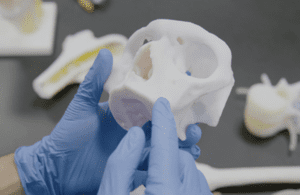
3D printing can create anatomical models like this skull. [Photo courtesy of Stratasys]
Stratasys today announced it signed an agreement with Ricoh to provide on-demand 3D-printed anatomic models for clinical settings.
Stratasys’ patient-specific 3D solutions use 3D printing technology from Stratasys, cloud-based Segmentation-as-a-Service solution from Axial3D and precision additive manufacturing services from Ricoh into one convenient solution. The new agreement builds on an existing relationship between Ricoh 3D for Healthcare and Stratasys to expand access to 3D-printed medical models.
Anatomic 3D-printed models are realistic and provide specific visualizations of a patient’s anatomy to allow practitioners to plan and practice complex surgeries and improve communication between medical staff, the patient and families. The company’s Digital Anatomy technology allows the models to be biomechanically realistic with the feel and responsiveness of real bone and tissue.
“With the advancement in imaging techniques and 3D-printing technology, we are seeing an increased demand for personalized solutions,” said Ben Klein, GM of patient-specific solutions at Stratasys. “We offer a simplified and scalable, comprehensive solution that increases access to patient-specific 3D-printed models in a fraction of time to help deliver highly personalized treatment and care.”
With the new collaboration, customers can upload medical files to a secure cloud-based service where Axial3D’s artificial intelligence-powered software automatically converts medical scans into 3D printable files. The files are printed on Stratasys 3D printers at Ricoh’s ISO 13485 certified facility, and the models are shipped directly to the care facility.
“We are providing an opportunity for healthcare providers to access state-of-the-art, precision additive manufacturing without absorbing the overhead costs,” said Gary Turner, managing director of additive manufacturing at Ricoh. “Offering this solution means democratized, wider access to patient-specific 3D-printed models that can improve outcomes and the patient experience, while also enhancing physician education and training.”